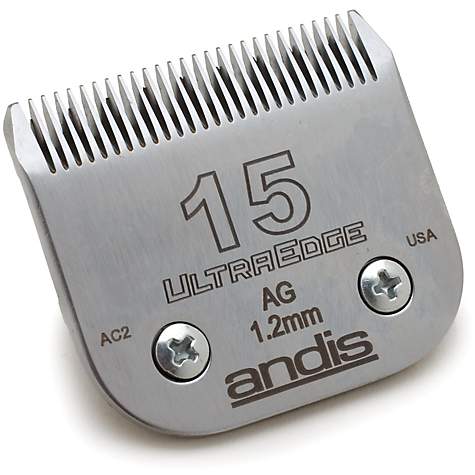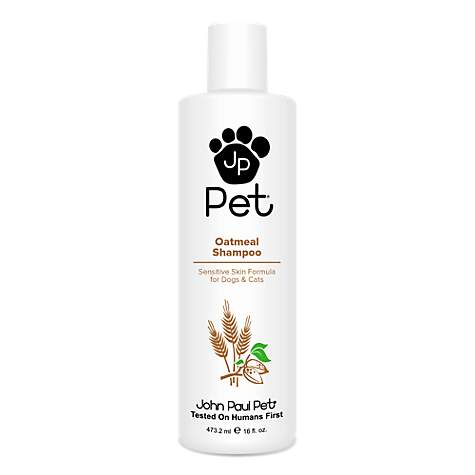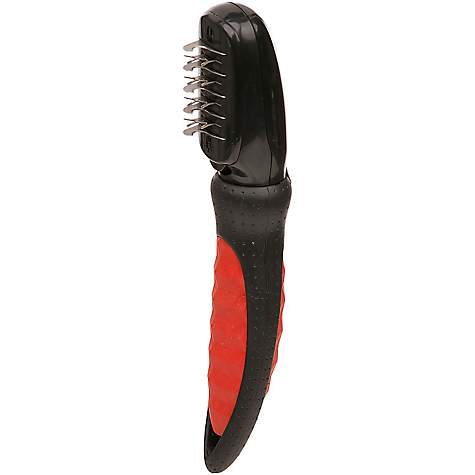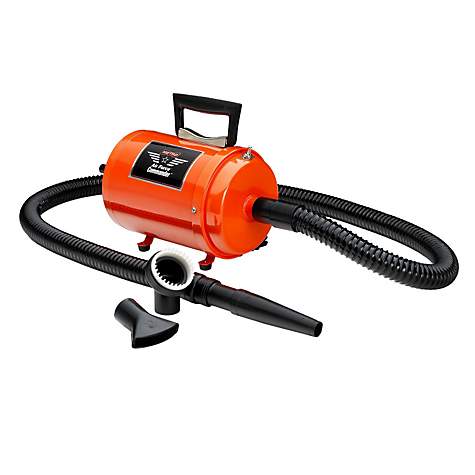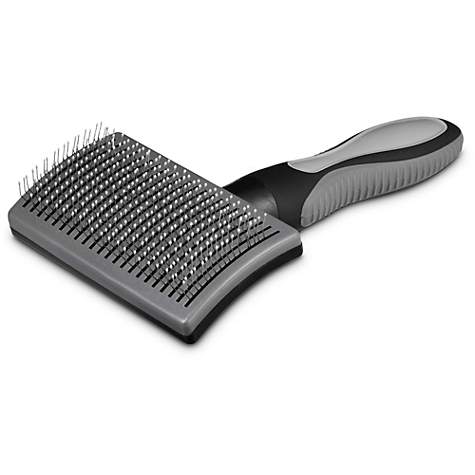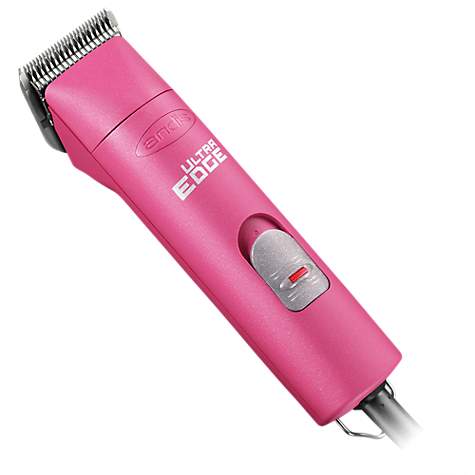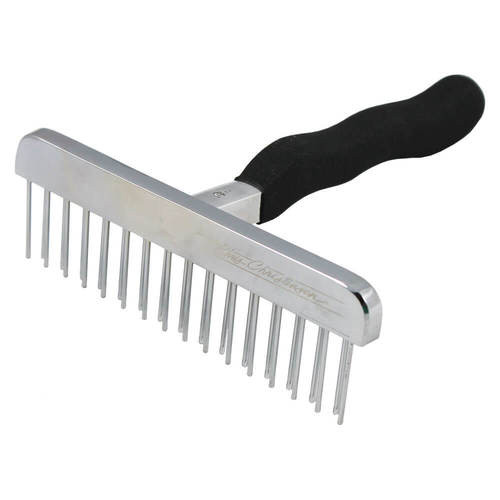Should you trim a Wooly? And HOW???
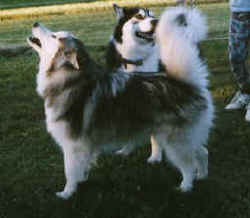 Featuring Stormy and River (whose owners
graciously consented to allow them to get really long and wooly so we could
do a demo for you!) and Tova, who unselfishly volunteered for a professional
"shave down" in the name of education :) and of course, our own wooly guy, Homer.
Featuring Stormy and River (whose owners
graciously consented to allow them to get really long and wooly so we could
do a demo for you!) and Tova, who unselfishly volunteered for a professional
"shave down" in the name of education :) and of course, our own wooly guy, Homer.
It depends.
First of all, I am not a "groomer" nor an expert of any kind. Through trial and error, practice, patience and a willing volunteer (Homer), I've managed to learn to do a passable job on Homer and his kids. My concern is this information is not covered ANYWHERE for the thousands of wooly Malamute pet owners out there and needs to be told. Many books and people out there can tell you how to line comb a correct coat, but nothing tells you what to do with a wooly! A visit to the groomer often nets a half-bald, or worse, shaved dog that no longer looks like a Malamute! I hope to spare others that negative experience so they can enjoy their wooly friends and their beautiful (when well groomed) thick coats.
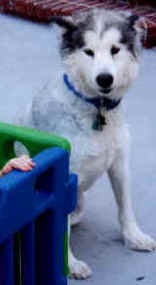
A Shaved Tova
Malamute fur is not meant to be trimmed and the coat can be ruined by a really "bad haircut" or shaving in certain areas, so the first rule is "go easy" because in a perfect world, you would keep the coat combed and never NEED to trim it. Also, there are is LONG-coat which is usually long, soft, straight and lies flat and can be up to 8" in length on some dogs - similar to a Collie's coat. WOOLY-coats are extremely thick, dense, oily and may even be kinky or coarse in texture but are not necessarily long. Unless wooly coats are long too, they don't need trimming.
The term "wooly" is usually incorrectly used for both kinds of coat. However, we are describing two very different types of coat and anything in-between! It's the combination of thick and long that makes maintenance a real chore. Also, it is not ethical or desired to show a sculpted or trimmed "long-coat/wooly" in the show ring. The Malamute is a natural breed and if a long-wooly coat is shown - it should ONLY be shown in it's natural state - LONG or WOOLY - never trimmed! And then there are some people that LIKE them long, maintain them well, and wouldn't dream of trimming at all!
A wooly/long coat is different than a normal
Malamute coat in that it "retains" shed fur. The old coat will not just fall
out like a normal coated dog. It must be combed out. This is why this kind of
coat is NOT correct (though the gene is in virtually all lines). Because the
fur can't fall out on it's own, it will usually matt if not maintained. The
prehistoric inuit would not have had the time or interest to "comb" their dogs
so the wooly dog, matted and heavy with ice and snow, would have been at a disadvantage
for survival. Fortunately we do not live in such harsh times. I have heard of
breeders in some countries "putting wooly puppies down", but for the most part,
we try nowadays to put them in pet homes on spay/neuter contracts where they'll
be cherished for their "inner" if not perfect "outer" beauty. 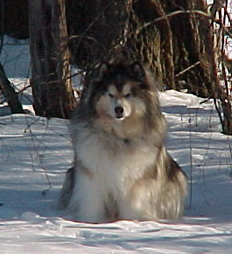
If a wooly/long coat is combed DAILY and thoroughly it may never need "trimming" at all. Many woolies are never trimmed and get by just fine (sometimes with a few matts here and there but nothing serious). But if your life becomes busy it's easy to fall behind in day to day care. Often these dogs are taken to groomers who have no clue how to "fix" the problem without a complete shave down or a painful dematting. Many Malamute owners wait too long to get their dog professionally groomed. To the groomer's credit, most will not want to hurt the dog and will recommend a complete "shave down". Many aren't aware other grooming methods exist - "How to trim a wooly/long Malamute" is not mentioned in any grooming textbook I know of.
If you have a loving pet, it won't be shown, and grooming is becoming a major chore and you have too little time...it may be better to trim some fur rather than allow the dog to become matted, unbearably hot or have lots of dead coat tangled in with the new. Below is some guidance to gently trim so that it's easier to comb out the shed fur so your wooly/long coat will always be presentable in a pet situation. In severe matting situations, it may be preferable to "shave" the dog rather than hurt it - but in a reasonably maintained dog this is seldom necessary or preferable.
A dog with hotspots, severe dense matting, or skin problems may require shaving or at least a very short cut in those areas to necessitate healing of the skin. Trimming a dog with the condition of "coat funk" is not recommended as the coat usually will not grow back properly. However, in a healthy dog without skin or coat problems a gentle trim may be preferable and attractive.
First of all - is it really a wooly or long coat? What may be considered "long" by some people in the western U.S., for example, is not considered a long coat in the east. It is merely a slightly longer normal coat which is perfectly correct. Some show people call this a "fancy coat" because of the longer breeches, belly hair, possibly tail hair, but all within the acceptable range for the standard. Malamutes come in many different coat lengths with guard hair 1/2" long at the nape to more than 8". A 5"guard coat at the nape is not too long and should NOT be trimmed. A true wooly/long coat will matt easily within a few days of not combing, and is usually longer than 5" at the nape of the neck. It will often look odd when wet (hanging and sometimes wavy). Also, keep in mind puppy coats may tend to be longer than the adult coat will be.
My personal preference is a good pair of electric dog clippers (I use this one - an Andis) with a #40 surgical blade, a 1-1/2" guide, a small sharp pair of scissors, a slicker brush and rake or dematter if necessary (usually is). Some people prefer to hand scissor - but if you have enough time to hand scissor you probably have the patience and enough time to comb the coat out naturally and leave it long - or you are doctoring a long coated dog for the show-ring (a no no anyway!). These instructions are for the typical pet owner (or groomer) that needs a reasonable solution for maintenance reasons to prevent matts and keep the coat maintainable in a family pet situation.
Comb out as many matts as feasible with the slicker brush, then give the dog a bath. A snip of the scissors into a really tight matt will often break it up enough to be combed out.
Dry thoroughly TO THE SKIN. Get the dog thoroughly dry or hotspots can develop from moisture near the skin. Hotspots are fungal infections due to moist conditions and can become red, itchy and painful with possible hair loss. While drying is an excellent time to look for skin problems as the hair parts easily under the dryer. If you don't own a high speed dryer - a canister vacuum set on 'blow' with a clean hose works well. A good hand-held people-dryer set on 'cool' will work, but the motor may tend to overheat and may not do an adequate job on a wooly. If you have a wooly, it's a good investment to buy a nice strong commercial dog dryer (they're available in many dog catalogs).
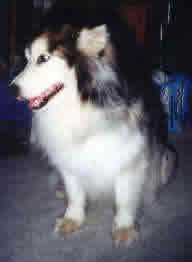
River illustrates overgrown feet
Comb again - even if you can't get the deep down stuff or really bad matts. They'll come out easier once the dog is trimmed anyway, so don't worry about it too much. There is no need to yank or pull but you may need someone to help hold a sensitive or wiggly dog. It's best if the dog can stand while you're trimming. If you have a grooming table and the dog is used to being on it - all the better. If not, just stand him on the floor. You'll better be able to see what you've done and the dog may feel less threatened by the clippers if she stands. Gather your equipment - a rake (or dematter), electric clippers, sharp pair of scissors, slicker brush.

Stormy has a very thick wooly coat.
Both coats are dense and long, but also quite soft which is typical of woolies. I usually trim the rear first because that is where woolies tend to matt the most. Sometimes that's all that needs trimming and if the owner prefers, (at this point, it's all we've done on Stormy) stop there and comb out the rest. To nicely sculpt the rear, hold the tail out straight and trim the long frondy ends on the tail that hang down about 1-2". Do not trim the top side of the tail. Some guard hair can be quite long in comparison to the undercoat, especially on the tail. You are only going to take off off guard hair and a little more, so that it is approximately the same length as the undercoat on the tail.
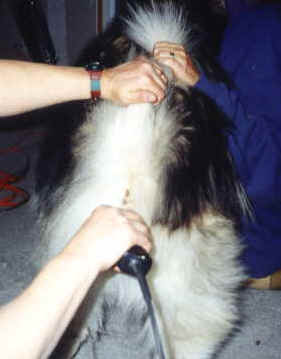
River
demonstrates holding the tail
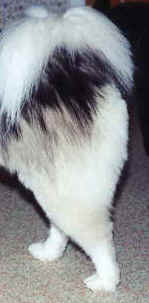
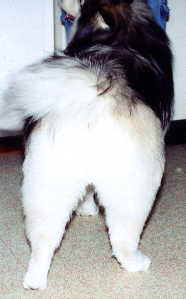
Stormy after all the "Kling-on's" are removed
If your dog is very long, you may want to trim a bit over the top of the rump or even on the back some, and this is accomplished by holding fur between the fingers and LIGHTLY skimming the tips with the clippers. Never more than 50% of it's total length. It really isn't necessary and should only be done if needed for balance with the rest of the trimmed coat. This method can be used on the hair standing up behind the ears too. Alternately, some people prefer to use a stripping comb on this area. If you use the clippers, be careful to just skim or it will not look natural. Your hand is there to keep you from getting too close. If you're not sure how much, do less than you thought. With experience you'll be better at it and better able to judge where to stop as well. Better a bit too long than a hack job
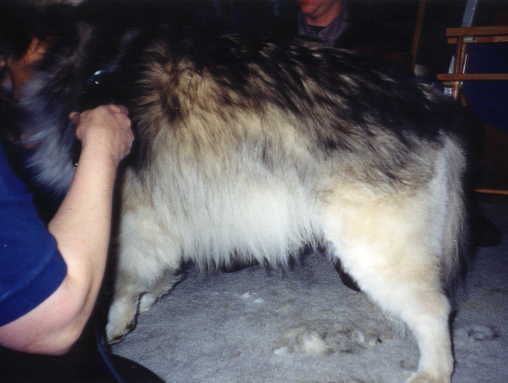
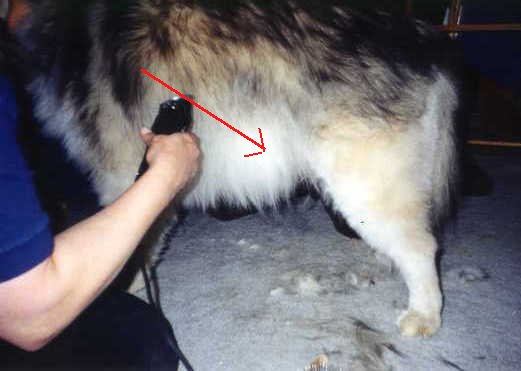
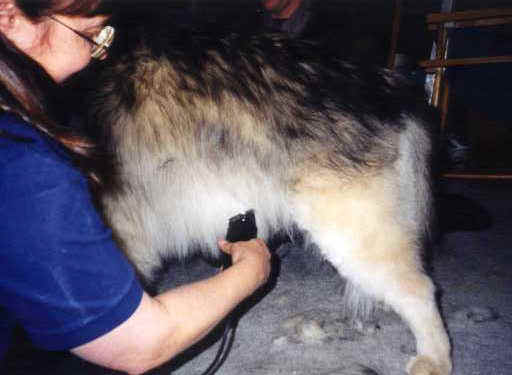
River gets a belly trim. Gently skim the fur, don't try and cut too deep too fast.
With the dog standing, start at the belly and
trim a line front to rear the length you would like the hair to be (usually
1-2"). This is your guide. With the clippers pointing down, flat side toward
the dog, gently stroke the dog's side fur at an angle, toward the rear curving
under to the belly. You may use just the corner of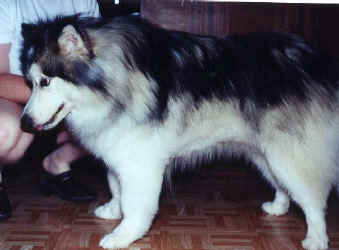 the clipper to gently blend
the dark into the light so there is not a distinct line. Always stroke the same
direction the fur grows - downward - NEVER go against the direction of fur growth.
Do both sides and try to keep them about the same length. Feathering with
just a corner of the clipper blade into the dark part of the coat will help
the coat to look more natural as it grows out. There should not be a distinct
line along the dog's side where you began trimming. It should blend as much
as possible. The softer the coat, the more difficult it is to blend well, but
if you're careful, it will look just fine in a couple of weeks as the coat grows
out.
the clipper to gently blend
the dark into the light so there is not a distinct line. Always stroke the same
direction the fur grows - downward - NEVER go against the direction of fur growth.
Do both sides and try to keep them about the same length. Feathering with
just a corner of the clipper blade into the dark part of the coat will help
the coat to look more natural as it grows out. There should not be a distinct
line along the dog's side where you began trimming. It should blend as much
as possible. The softer the coat, the more difficult it is to blend well, but
if you're careful, it will look just fine in a couple of weeks as the coat grows
out.
Stormy after the preliminary belly trim. The blending hasn't been done yet. We don't want a definate "line" so feathering will be done so that as it grows out it will look more natural. Trim the hock (behind the foot), between the toes of the foot, and clip toenails. If a very long wooly, you may need to trim "around" the foot and pulling up the hair between the toes so it can be trimmed. Trim the top of the foot slightly so it looks neat and compact. If you have a clipper guard, you may use it for the top of the foot so you don't cut too close.

Before and After a foot trim - neater looking and tracks in less dirt from outside
Next, the dogs chest. Carefully skim from the neck down and around under the chest. This is a difficult area to do well so trim and comb as you go. Clippers upside down and going down, skim down and around under between the legs. Take off any "stray hair" that is sticking out on the front of the shoulder area so that it blends nicely. Combing as you go will help you get it more even as it tends to "pack down" where you can't see it then "pop up" after you THINK you're done!
Some woolies need trimming on the backs of the front legs. To do this, it must be combed as best you can first. Matts will make it more difficult to do nicely. Starting at the elbow, and cutting into the undercoat, bring the clippers straight down through the dense fur at a depth you like (never shorter than the front leg hair is long). Using this as a guide, continue taking fur off (in a down motion) around the back of the leg. Blend with the sides of the leg. Do not take fur off the front of the leg or it will look unnatural. If the front leg hair is also excessively long, a 3/4" guide over the blade works well - but understand the dog will look "choppy" for 3-4 weeks afterward so I don't recommend doing this unless the dog is VERY long in that area. The FRONT of the leg rarely matts badly even if neglected.
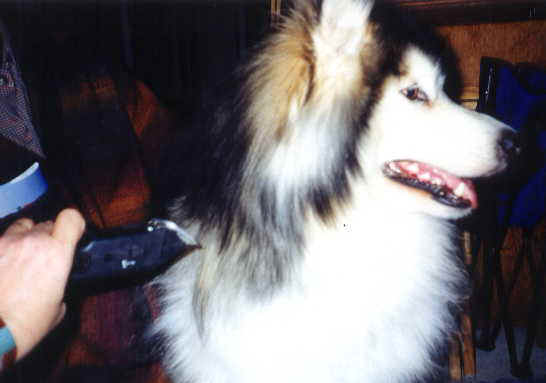
River getting a neck trim (notice how the clipper
is held)
Neck areas seldom need to be trimmed drastically and will look funny if they are. A light skimming for blending reasons and to get the longer guard hairs that have a "Lion's mane" type of look. If you really want it shorter, then only trim by skimming in the direction the hair grows a little at a time. Again, NEVER trim backwards.
I prefer the dog lie on it's side to even up the belly, trim armpits and between the legs. That way I can better see if there are any matted areas I missed. If there are no matts, the 3/4" guide on the blade makes it easy. Do inside the back legs, the belly and blend toward the chest, taking the long fronds out of the armpits with the guide on the clippers. Do not go too far up his sides where you've already blended the coat. Here going against the growth of the fur doesn't matter so much and is sometimes preferable. A very matted or sensitive dog may need to have the belly, armpits, inside legs and toward the chest shaved close to the skin as opposed to pulling to get the matts out. If the weather is very hot, you may want to do this anyway for the dog's comfort so she can better enjoy the bathroom's tile floor! Either way, better to shave than hurt the dog tugging on bad matts in a very sensitive area. If you're careful, the bare areas will never be seen because the rest of the fur is still long enough to conceal these areas and hopefully you blended this a bit too. (But, Malamutes being Malamutes, no doubt they will flip over for a belly rub and show visitors every crooked cut!). If the dog will not lie still, this can be done standing, but it is not as easy to get the armpits and between legs while standing.
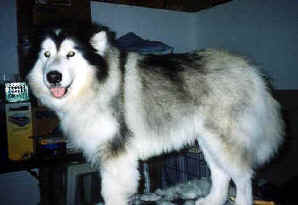
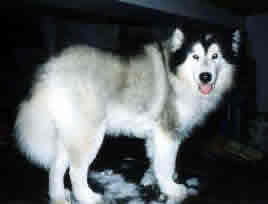
Homer before and one side done. You can see about how much has to be taken off if you don't wait until the dog is really really long. It is much easier to blend if you don't wait as long between trims.
The most challenging aspect of trimming a wooly/long coat is blending. If you don't wait as long between trims it will be easier as you'll have the previous cut to follow. Use the corner of the electric clipper blade to gently sweep the fur to blend. NEVER cut into the fur deeply - particularly the undercoat (except the areas mentioned). Everything is done with a gentle dusting/sweeping motion taking off as little as possible at a time. Think of yourself as an artist, painting your impressionistic VanGough.
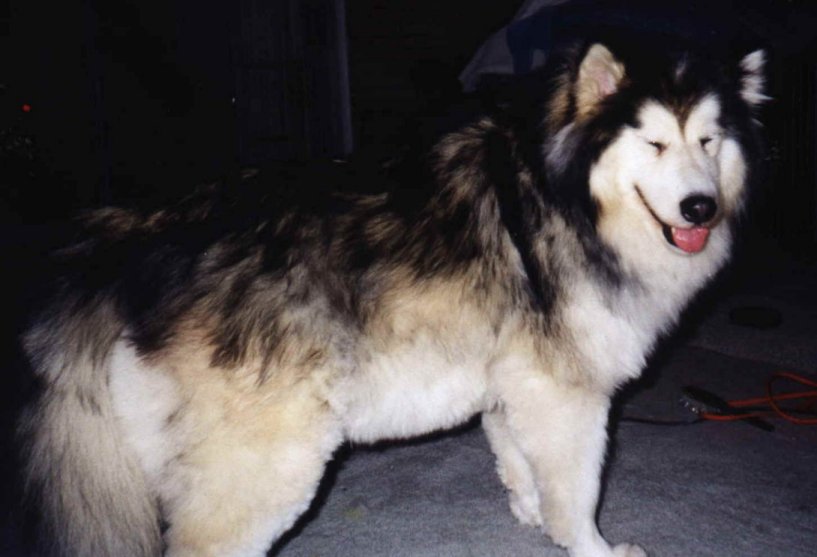
After a preliminary 'trim' brush the dog out. This is when you will dematt or cut out any matts you couldn't get out earlier. Often a snip into a tight matt will allow it to be gently pulled apart with a rake or dematter. Work slowly and give the dog several breaks and cookies as rewards for cooperation! At the next break, study your work and see where it looks uneven, needs blending, or any loose fronds and tufts sticking out. Trim out the unevenness carefully. Don't be a perfectionist or too hard on yourself - in a couple of weeks it will look fine and if it doesn't you can touch up your work again.
Voila! Your beautiful wooly (or perhaps not so beautiful if this is your first attempt) now has a MANAGEABLE coat that is comfortable and matt-free. If your efforts are less than perfect, don't worry, you can try again in a few weeks and with each attempt you WILL get better! As the fur grows, any choppiness will grow and blend in so what may look like a bad haircut today, will look much better in two weeks. With regular maintenance - and depending on growth rate, touch-ups may be necessary every 2-6 months - your wooly can be a beautiful (if long) representative of the Alaskan Malamute breed. After all, they always have such beautiful temperaments - why not a beautiful coat too?
A pin brush is great for light touch ups in between grooming sessions, but don't expect it to do it all...a pin brush won't get down to the skin.
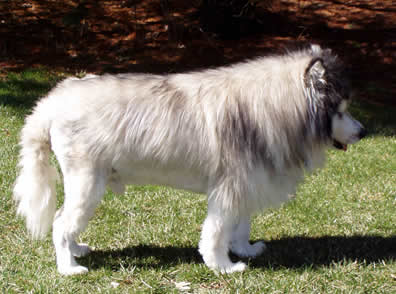 Tip for Old Woolies :
Tip for Old Woolies :
As Homer was getting older, we had to deal with some serious aging issues. One being, he had been stool incontinent for quite a long time. This presents quite a problem with a normal Malamute coat, but is a huge problem with a wooly. Since it was almost impossible to keep him meticulously clean as we have always kept him, we've had to come up with a compromise solution due to his age. Below is a picture of Homer's "mal-oodle cut". Our reasoning is that when he sees himself in a refection he still sees the same fuzzy guy. We would hate for him to be embarrassed! However, it makes maintenance much easier for us. He doesn't seem to mind at all as he likes to be clean. He is having difficulty getting up, using stairs and into a tub so this "haircut" has allowed him to live out his senior years without constant baths (though sometimes he needs them, sometimes it's just better to cut off the icky stuff and spare him the trauma of being lifted into the tub - his hair still grows back really fast so getting him too short is not a problem except in the coldest months of winter!).. He also has less patience for being combed and tends to urinate when combed in certain areas near his rear. Having the hair short in these areas has made it easier to comb the hair that is left long. (When we trim, I make sure to put something to soak up the urine under him). The hair is trimmed to less than a half inch where short and on the underside of the tail (though my "shaving" ability leaves a LOT to be desired ;-).

